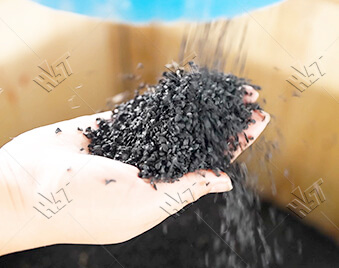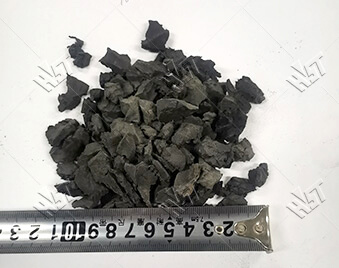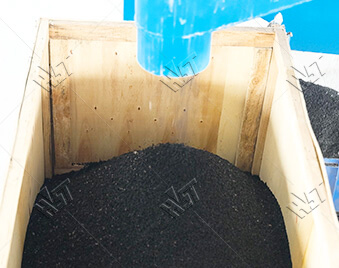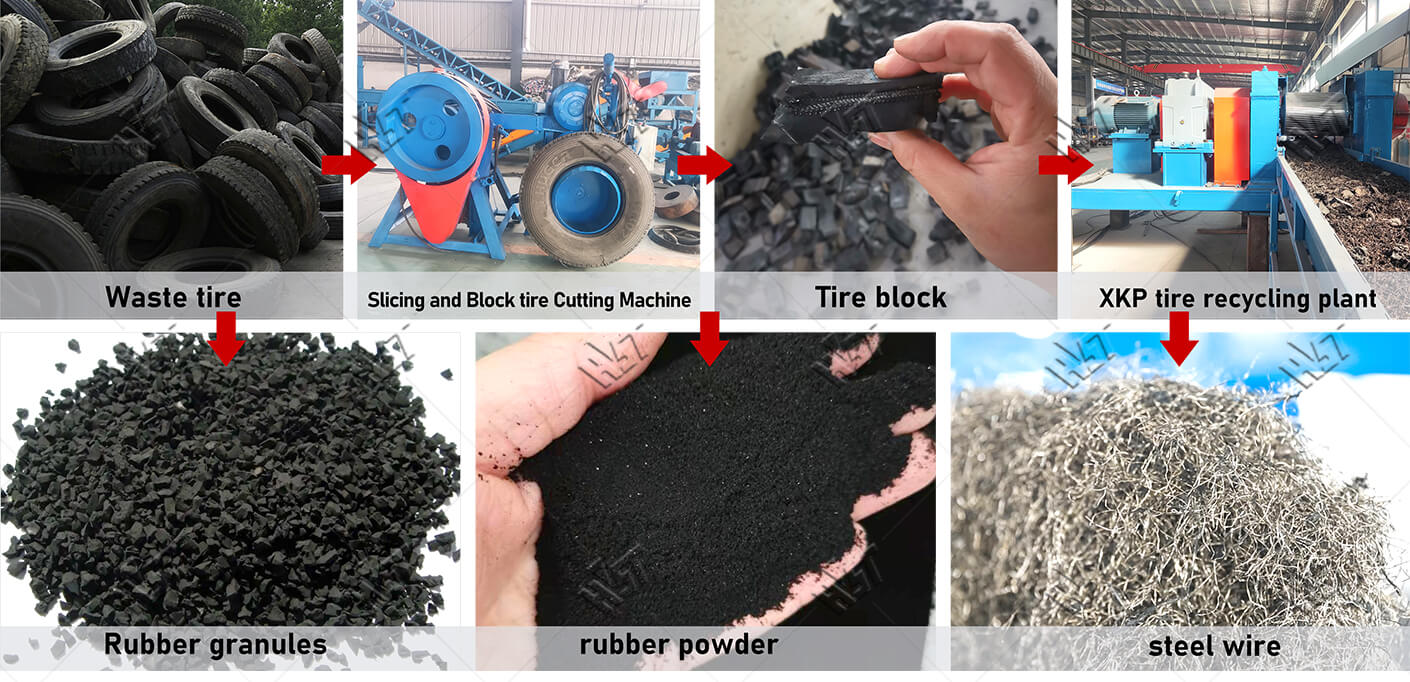Crumb rubber is a finely ground material produced from end-of-life tyres, typically less than 1mm in size. This high-quality tyre-derived material (TDM) retains the resilience, elasticity and durability of the original rubber, making it ideal for a wide range of advanced industrial and infrastructure applications.
Crumb rubber is made of recycled tires that are cleaned, ground into smaller pieces and screened to obtain uniform sizes. Crumb ranges from particles so tiny they resemble dust to pieces about one-half inch long, or a little smaller than a dime.
Crumb rubber is the name given to any material derived by reducing scrap tires or other rubber into uniform granules with the inherent reinforcing materials such as steel and fiber removed along with any other type of inert contaminants such as dust, glass, or rock.



Crumb rubber is manufactured from two primary feedstocks: tire buffings, a byproduct of tire retreading and scrap tire rubber. Scrap tire rubber comes from three types of tires: passenger car tires, which represent about 84 percent of units or approximately 65 percent of the total weight of U.S. scrap tires; truck tires, which constitute 15 percent of units, or 20 percent of the total weight of U.S. scrap tires; and off-the-road tires, which account for 1 percent of units, or 15 percent of the total weight of U.S. scrap tires. End product yields for each of these tire types are affected by the tire’ s construction, strength and weight. On average, 10 to 12 pounds of crumb rubber can be derived from one passenger tire.
Shredding and Grinding: First, the tires go through shredding machines that break them down into smaller pieces. These pieces are further ground until they become small, uniform granules, known as crumb rubber.
Steel and Fiber Separation: Tires contain steel wires and fabric materials for reinforcement. During the grinding process, magnets and other separators remove these non-rubber components, leaving only clean, pure rubber.
Size Sorting: The rubber granules are then sorted by size, as different applications require different particle sizes. For instance, fine granules are used for artificial turf infill, while coarser pieces may be used for larger projects like playground surfaces.
Final Processing: Depending on the intended use, It may undergo additional processing steps, such as adding chemical treatments or further refining. This ensures the rubber meets specific safety and durability standards.
At Greenrubber, we are one of the leading suppliers of eco-friendly recycled rubber products. We’ve developed a meticulous, environmentally-conscious process that maximizes the quality while reducing overall waste.
Ambient Mechanical Grinding
In ambient mechanical grinding process, the breaking up of a scrap tire happens at or above normal room temperature. Ambient grinding is a multi-step technology and uses whole or pre-treated car or truck tires in the form of shred or chips, or sidewalls or treads. The rubbers, metals and textiles are sequentially separated out. Tires are passed through a tire shredder, which breaks the tires into chips.
The chips are fed into a granulator that breaks them into small pieces while removing steel and fiber in the process. Any remaining steel is removed magnetically and fiber through a combination of shaking screens and wind sifters. Finer rubber particles can be obtained through further grinding in secondary granulators and high-speed rotary mills.
Ambient grinding is the production process used by the majority of crumb producers. The machines most commonly used for fine grinding in ambient plants are:
Secondary granulators
High speed rotary mills
Extruders or screw presses
Cracker mills
Cryogenic Grinding
Cryogenic grinding refers to the grinding of scrap tires at temperatures near minus 80oC using liquid nitrogen or commercial refrigerants. Cryogenic processing generally uses pre-treated car or truck tires as feedstock, most often in the form of chips or ambiently produced granulate.
Processing of scrap tires takes place at very low temperature using liquid nitrogen or commercial refrigerants to embrittle the rubber. It can be a four-phase system which includes initial size reduction, cooling, separation, and milling. The material enters a freezing chamber where liquid nitrogen is used to cool it from –80 to –120 °C, below the point where rubber ceases to behave as a flexible material and can be easily crushed and broken.
recycling of scrap tires
Because of its brittle state, fibres and metal are easily separated out in a hammer mill. The granulate then passes through a series of magnetic screens and sifting stations to remove the last vestiges of impurities. This process requires less energy than others and produces rubber crumb of much finer quality.


Retreaders tire buffings shall consist of clean, fresh, dry buffings from tire retread preparation operations.
No.1 – Tire Granule shall consist of granulated tire crumb, Black Only Guaranteed MetalFree, sized. Magnetically separated materials are not acceptable. Fluff from tire cord removed.
No.2 – Tire Granule shall consist of granulated tire crumb, Black & White Guaranteed MetalFree, sized to minus 40 Mesh. Magnetically separated materials are not acceptable. Fluff from tire cord removed.
No.3 – Tire Granule shall consist of granulated tire crumb, Black Only Magnetically Separated, sized. Fluff from tire cord removed.
No.4 – Tire Granule shall consist of granulated tire crumb, Black & White Magnetically Separated, sized. Fluff from tire cord removed.
No.5 – Tire Granule shall consist of unclassified granulated tire crumb, Sized, Unseparated, not magnetically separated, fluff from tire cord not removed.
Crumb rubber offers the most versatility for recycled tires and arguably the highest value, as compression and injection molders, paving companies and synthetic turf installers use it to design a wide range of helpful products we encounter every day.
The trend towards use of recycled materials has increased the demand for crumb rubber. The manufacture of asphalt rubber is the largest single application of crumb rubber, consuming an estimated 220 million pounds, or approximately 12 million tires annually. Crumb rubber can be blended with asphalt to improve the properties of the asphalt used in highway construction.
Crumb rubber has other applications, including ground cover under playground equipment, running track material, and as a soil additive in sports and playing fields. Other uses for crumb rubber include molded rubber products (e.g., carpet underlay, dock bumpers, patio decks, railroad crossing blocks and movable speed bumps); new tire manufacturing; automotive parts such as brake pads and shoes; as an additive to injection molded and extruded plastics and as agricultural and horticultural applications/soil amendments.
Synthetic Turf Fields (Infill)
Molded Rubber Products
Rubber Flooring
Animal Bedding
Rubber-modified Asphalt
Running Tracks
Roofing Materials
Some of the major applications of crumb rubber are as follows:
Kindergarten Playgrounds and Recreation Areas
School Sports Areas
Athletic Tracks
Tennis and Basketball Courts
Bumpers
Splash Guards and Fenders
Floor Mats for Cars and Trucks
Floor Liners for Trucks and Vans
Hospital, Industrial, and Bathroom Flooring
Floor Tile
Foundation Waterproofing
Dam, Silo, and Roof Liners
Rubberized Asphalt for Roads and Driveways
Drainage Pipes
Soil Conditioner
Porous Irrigation Pipes
Road Building and Repair
Adhesives and Sealing Compounds
Textured and Non-Slip Paints
Roof Coating and Waterproofing
Shock Absorbing Pads for Rails and Machinery
Sound Barriers for Highways
Abrasion Lining in Mining Equipment
Pipe Insulation and Lining
Garbage Cans
Shoe Soles and Heels
Wire and Cable Insulation







It offers significant environmental benefits, primarily through waste reduction. It offers several environmental advantages:
Energy Conservation: The production requires less energy than the production of new tires. This energy savings can help to reduce our overall energy consumption and reduce our carbon footprint.
Reduced Landfill Waste: By recycling used tires into crumb rubber, we significantly reduce the amount of waste that ends up in landfills. This helps to conserve landfill space and reduce the environmental impact associated with landfill operations.
Increased Property Values: Its uses in landscaping and construction projects can increase property values. For example, using crumb rubber in playground surfaces can make properties more attractive to families and increase their value.
Enhanced Product Longevity: Products made, such as rubberized asphalt and playground surfaces, often last longer and perform better over time compared to traditional materials, further driving down replacement costs.
It has emerged as a valuable resource with a wide range of applications. Its production process, environmental benefits, and economic potential make it a sustainable and attractive material for various industries. As technology continues to advance, we can expect to see even more innovative uses in the future.